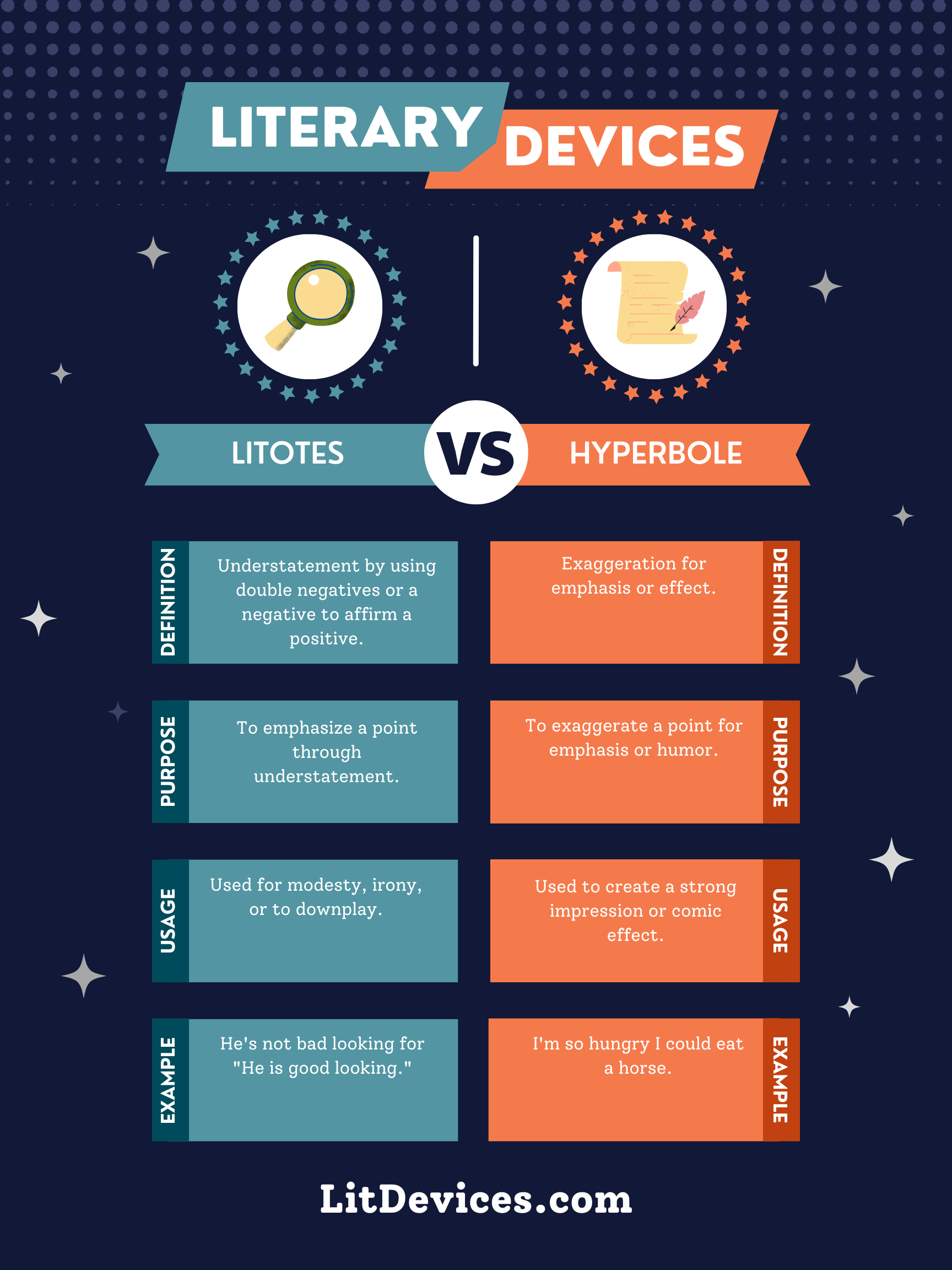Litotes is a figure of speech that employs understatement by using double negatives for a subtle effect; Hyperbole involves exaggerated statements or claims not meant to be taken literally.
In the dance of communication, litotes and hyperbole are steps at opposite ends of the floor. Let’s explore these contrasting yet captivating literary devices. 🎭📚
Litotes
Litotes achieve emphasis by denying the opposite of what is meant, creating an understatement that can add depth or irony to a statement. A classic example is saying, “He’s not bad looking,” to suggest someone is quite attractive without directly stating it.
Hyperbole
Hyperbole is the deliberate use of overstatement or exaggeration, often for comic effect or to heighten emotional response. “I’ve told you a million times” exemplifies hyperbole, using exaggeration to express the speaker’s frustration over repetition.
Summary
| Literary Device | Definition | Purpose | Usage | Relevant Examples |
|---|---|---|---|---|
| Litotes | An understatement by using double negatives or denying the contrary. | To subtly emphasize or add irony. | Poetry, prose, everyday speech. | “He’s not bad looking.” |
| Hyperbole | Exaggerated statements or claims not meant to be taken literally. | To amplify effect, add humor, or heighten emotion. | Poetry, prose, speeches, everyday speech. | “I’ve told you a million times.” |
Writing Tips
For Litotes:
- Use Sparingly: Too much understatement can muddy your message. Use litotes for specific emphasis or to convey a tone of modesty or irony.
- Double Negatives: Skillfully employ double negatives to subtly convey your actual message without stating it outright.
For Hyperbole:
- Know Your Audience: Ensure your audience understands the exaggeration for what it is. The purpose is to entertain or emphasize, not to mislead.
- Balance with Content: While hyperbole can add flavor, it should not overpower your message. Use it to enhance rather than distract.
FAQs
Can litotes and hyperbole be used together?
Yes, though they serve opposite functions, they can be used in tandem within a work to create varied emphasis and tone.
How do I choose between litotes and hyperbole?
Consider your objective: if you aim to subtly strengthen a point or add irony, litotes is effective. Use hyperbole when you want to dramatically underscore a statement or evoke strong emotions.
Exercise
Read the following sentence and determine if it’s an example of litotes or hyperbole:
“After waiting forever, I finally got a response.”
Answer: This is an example of hyperbole, using “forever” to exaggerate the length of the wait.
Other Interesting Literary Device Comparisons
- Metaphor vs Simile: Both compare two unlike things, but metaphors do so directly, while similes use “like” or “as.”
- Irony vs Sarcasm: Irony involves saying the opposite of what one means, often subtly, while sarcasm is a form of verbal irony intended to mock or convey contempt.
- Personification vs Anthropomorphism: Personification attributes human qualities to inanimate objects or concepts, whereas anthropomorphism gives human traits to animals or objects, often making them characters in a story.
Exploring these devices enriches our understanding and appreciation of the intricate dance between meaning and expression in literature. 📘💫

